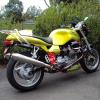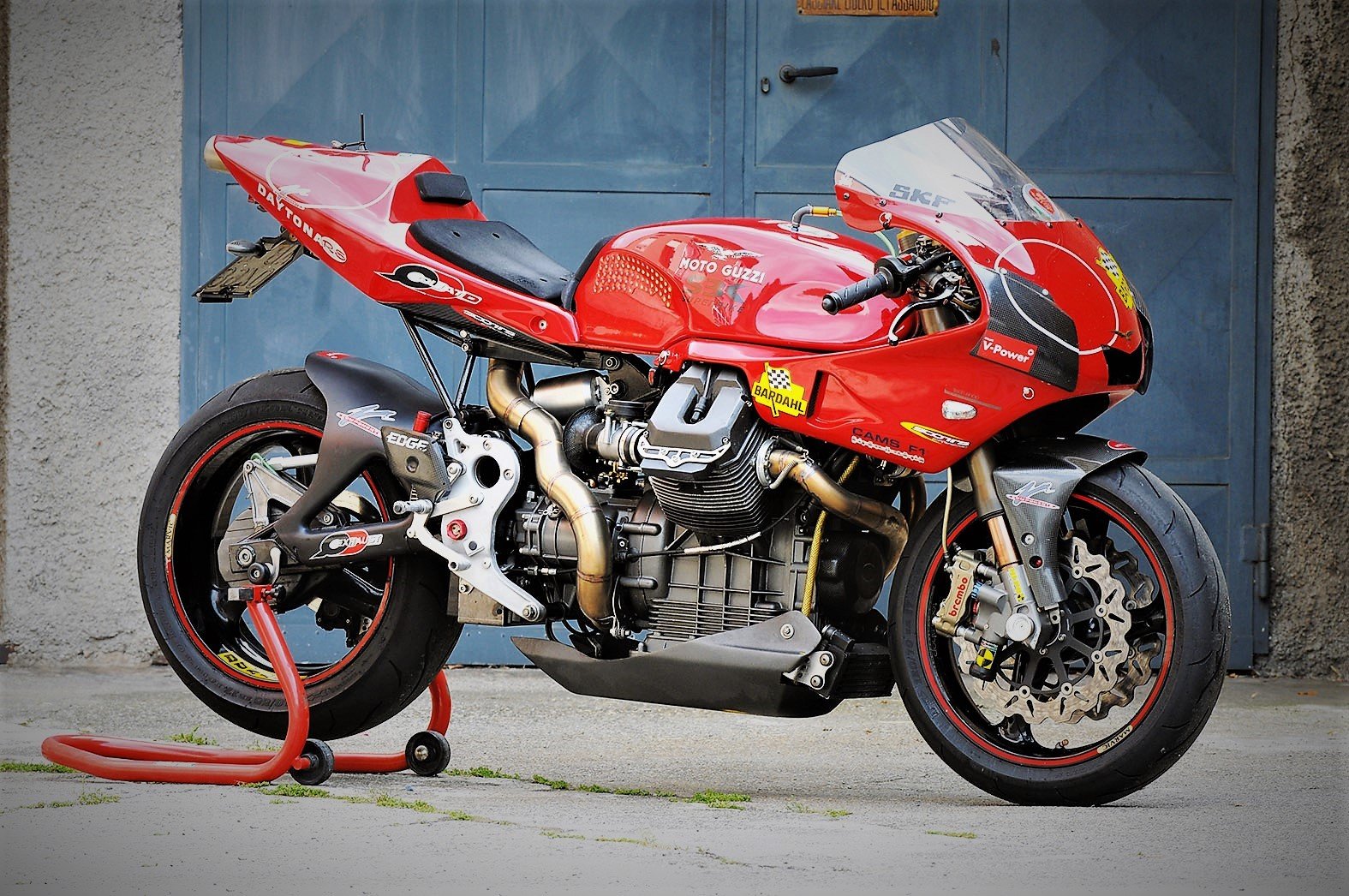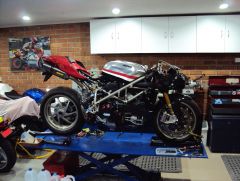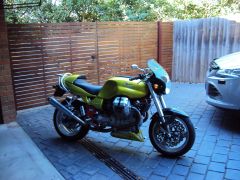-
Posts
5,449 -
Joined
-
Last visited
-
Days Won
276
Content Type
Profiles
Forums
Events
Gallery
Community Map
Everything posted by Lucky Phil
-
Agostinis, nice quality, good fit, not too loud nice brushed SS finish. About the same sound and volume as Conti's on a Bevel Ducati but without the sharpness, more mellow due to the Guzzi's softer cam profile. https://www.v11lemans.com/forums/index.php?app=gallery&image=1981 Had a set of reverse cone Mistrals and they were a bit loud and had an annoying whistle on the overrun, but looked a little better. Ciao
-
Now ther's a geographical contrast docc from the previous image of SoCal to central Kentucky. Both look nice in their own individual way. Ciao
-

Anyone seen or tried these? Andreani Fork Cartridge Kit
Lucky Phil replied to Unkept's topic in 24/7 V11
Another thing to consider is the Green bikes forks were different to the next model I believe in that the axle on the later threaded into the L/H fork lower where the earlier bikes the axle slid through and had a big nut holding the front together. Dont know if it makes a difference or not. Ciao -
Yes it is, the Stucci is the best cross over although this one has been beaten on for I suspect centrestand clearance. Ciao
-
Yes Italian translation. It could also be linked to how the assembly line process works. So if for the purposes of production assembly ease they have an air operated tool that installs and torques the axle from the bevel box side in one operation and they hold the nut with a spanner or other tool then the manual writer will use that discription and value even if it doesnt apply in the non production world. Ciao
-
Yes Chuck thats true. Although lockwire for instance isnt to stop a bolt coming loose, its to stop it falling out of the hole and fowling other stuff if it does. The reasons a bolt in a clamping application loosens is because. A....it was undertorqued. B....it was of insufficient strength and stretched under load to its yield point but (not necessarily) to failure point thus losing its tension. C..it was subject to fretting of the threads usually due to resonant vibration and therefore lost its tension/stretch due to wearing threads. D..the bolt used was too short and had insufficient stretch for the applied torque. In all these cases lockwire wont prevent the bolt from losing its clamping force and so its basically useless even if its still in the hole. The previous flight control nut example doesnt apply to the axle nut as most flight control bolt and nut applications such as this are rod end and/or clevis and the bolts are primarily taking shear and rotational loads and sometimes adequate bolt stretch is hard to achieve so more elaborate locking requirements are needed such as nylock nuts, pinning, locking tabs or a combination. A correctly torqued axle nut doesnt require a locking facility in my opinion. I've never seen one come loose that was correctly torqued in over 50 years. Honda once said that the reason they lockwired bolts on their race bikes wasnt to do with bolt retention but because they believed no one would be stupid enough to lockwire a bolt that wasnt tightened up in the first place. Ciao
-
My Greeny now has the adjustable small eccentric pin and the banana plate via the Guzzi upgrade kit. The banana plate doesnt make a difference worth the updating in my view. Dont know why they bothered really. Thats Guzzi though updating stuff that doesnt need to be and ignoring stuff that does. Bit like developing hydraulic lifters that dont require adjusting for an engine with the most easily adjustable valves clearances in piston engine history:) Ciao
-
Axle "Locking" nuts are really not required. My bike is fitted with Titanium non locking nuts front and rear with no issues as have been a hell of a lot of production motorcycles over the years including every Ducati I've ever owned including race bikes that have competed in the IOM. Its just another analy retentitive Guzzi idea thats not really necessary. Ciao
-
Docc as Chuck pointed out you can buy sleeves to press over the damaged surface to provide a new surface for the seal to run on. If the damage isnt too deep you may be able to get the nose ground and the seal still have enough tension to do its job. Seals of this size generally have a couple of mm interference on the sealing surface so a 10 or 15 thou regrind wont matter if thats what it takes to get the damage cleaned up. Ciao
-
I think you'll find the inner seal runs on the nose of the crownwheel not the axle. As I mentioned its also important to use OEM directional seals in these applications where the seal is difficult to access and or requires a lot of disassembly to replace. Ciao
-
Oh ok docc. Yes painfull. Ciao
-
Docc we always go one of 2 ways, take the easy simple option or the most complicated one. The obvious option for oil leaks is the seal and the less obvious is the flange/spacer it runs on. This can be out of round, under or oversize ( oversize burns out the seal) or it can have a microscopic surface blemish which goes unnoticed unless you look at it with a glass or are specifically looking for it. The other issue is sometime a worn bearing with too much play asking the seal to do too much. Years ago a friend of mine had a persistent oil leak from the clutch seal on 1986 Ducati Hailwood replica since new. Dry clutch on these with a large seal even bigger than the Guzzi bevel box seal. He just kept putting in new seals and got frustrated with it. I asked him to show me the primary gear so I could inspect the seal flange and there on the flange was a tiny spiral mark from the original grinding operation at the factory. Chuck it up in the lathe and hit it with some 1200 emery and polish it up and issue solved. He just kept looking at the obvious and simple option. The other area is of course the seal housing and its surface condition and concentricity as well as the control of the seal depth. Have you been using the OEM directional seals? Might be time for a complete strip down, measure up and detailed inspection of the other stuff. Ciao
-
But I am electrifying...boom tah:) Ciao
-
Yes, but not all selectors have this, some have a roll pin that realistically cant be removed. Ciao
-

Odometer stopped working - 2004 V11 Cafe Sport
Lucky Phil replied to GuzziPet's topic in Technical Topics
How could it be a cable issue if the speedo needle still works? More likely an internal failure of the odo drive, tapping the instrument free'd up/disconnected the speedo from the odo. Ciao "Symptoms were slowing turn over on the dial and dancing speedometer needle." Just trying to go by what he said. My assumption was that the failing internal odo drive was effecting the speedo needle stability which seems to be the case as when the odo drive failed and disconnected the speedo needle returned to normal ops. Ciao- 29 replies
-
- odometerCafe SportV11
- 2004
-
(and 2 more)
Tagged with:
-
With all due respect and exception to our own docc, I've yet to meet a doctor that approved of getting on a motorcycle even when you are feeling 100% Sometimes its about the mental wellbeing over the physical. A few times I've had very serious injuries and got on the bike and its been ok and I've thought, well if I can still ride the bike then I'm going to be fine. Ciao
-
When I was going through the Sport upon it's arrival, I found the airbox full of tar, and it took 4-5 times of very serious chemical assault to clean the mung out of the TBs and throttle plates. I used an entire can of carburetor cleaner, and nearly an entire can of TB/intake specific cleaner to get 95% of it out. I've never seen anything like it. The odometer showed only ~20k miles, but the bike's obviously been down so it's possible it isn't the original. Can I suggest you buy a small ultrasonic cleaner off ebay ( they are very affordable) to make this job and many others very quick and easy. Ciao you mean as in *take it apart*? I'll apply the 80/20 rule any time 80% is 100% serviceable and invisible. Not sure I understand but yes, take the TB's off and ultrasonic them. No need to disassemble them just clean them as a pair. Removal and refitting is therapeutic, its shed time, mans time,red wine and musing time, reflection time. Time well spent:) Ciao
-
When I was going through the Sport upon it's arrival, I found the airbox full of tar, and it took 4-5 times of very serious chemical assault to clean the mung out of the TBs and throttle plates. I used an entire can of carburetor cleaner, and nearly an entire can of TB/intake specific cleaner to get 95% of it out. I've never seen anything like it. The odometer showed only ~20k miles, but the bike's obviously been down so it's possible it isn't the original. Can I suggest you buy a small ultrasonic cleaner off ebay ( they are very affordable) to make this job and many others very quick and easy. Ciao
-
Biggest breather tank you can fit in the space ( with an oil seperator if possible ) available with a drain back line and the tank vented via a tube out the back of the bike. Ciao
-
Nice, the silver bikes always photograph really well. Ciao
-

Odometer stopped working - 2004 V11 Cafe Sport
Lucky Phil replied to GuzziPet's topic in Technical Topics
How could it be a cable issue if the speedo needle still works? More likely an internal failure of the odo drive, tapping the instrument free'd up/disconnected the speedo from the odo. Ciao- 29 replies
-
- odometerCafe SportV11
- 2004
-
(and 2 more)
Tagged with:
-
I was confused reading all the Thruxton references in these last couple of posts and compairing to a V11. I kept thinking of my friends Velocette Thruxton that I've ridden and thinking it was never a match for a V11. Then I remembered there's a modern version....doh Ciao
-
A Scura with lipstic. Ciao
-
From the album: lucky phils V11




